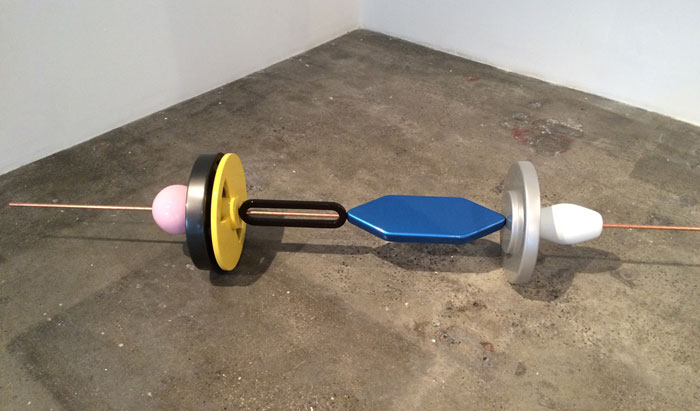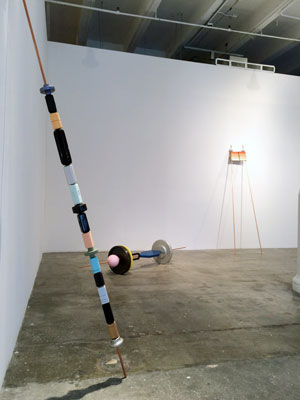by Heather Zises
Photos Courtesy of the Fridman Gallery
 Known for his conceptual sculptures that resist categorization, multimedia artist Reuven Israel creates unique, brightly colored modular artworks that are embedded with paradoxes and layers of meaning. Each work explores metaphysical tropes that span sophisticated notions of divinity, sanctity, the uncanny, and science fiction, while embodying vaguely symbolical forms. All of Israel’s sculptures are unique, and involve components that turn, spin, lean, drill or surrender. They are designed with a metaphysical bent, becoming objects that represent the intangible—quite possibly they possess invisible energies, an innerlife, or even talismanic power. Born in Jerusalem and raised in Tel Aviv, Israel earned both his BFA and MFA from Bezalel Academy of Art and Design. The artist has exhibited worldwide, and currently lives and works in Brooklyn.
Known for his conceptual sculptures that resist categorization, multimedia artist Reuven Israel creates unique, brightly colored modular artworks that are embedded with paradoxes and layers of meaning. Each work explores metaphysical tropes that span sophisticated notions of divinity, sanctity, the uncanny, and science fiction, while embodying vaguely symbolical forms. All of Israel’s sculptures are unique, and involve components that turn, spin, lean, drill or surrender. They are designed with a metaphysical bent, becoming objects that represent the intangible—quite possibly they possess invisible energies, an innerlife, or even talismanic power. Born in Jerusalem and raised in Tel Aviv, Israel earned both his BFA and MFA from Bezalel Academy of Art and Design. The artist has exhibited worldwide, and currently lives and works in Brooklyn.
Currently on view at Fridman Gallery is MULTIPOLARITY, a playful survey of robust, three-dimensional objects that resemble curious syringes ready to inject the viewer with a cosmic cocktail of art and science. Comprised of geometric forms of varying shapes, sizes, and colors that are skewered onto thin copper poles, the sculptures command attention with their machine made look and keen likeness to familiar, everyday objects. Upon closer examination, the viewer realizes Israel’s sculptures are meticulously man made, and curry favor to form over function. If you look long enough, one begins to discover slight imperfections and flaws amongst the objects, which humanizes them. Subsequently, many of Israel’s sculptures seem to hum with an invisible energy that stem from the spine of their copper core. It is as if at any moment the works could levitate and hover like a UFO or spacecraft. Complex yet elemental, scientific yet domestic, futuristic yet historical, each sculpture revels in differences and juxtapositions, while striving to unite antithetical forces into a harmonious continuum.

Similar to 1960s Minimalist sculpture, Israel’s works are material and process-based, yet they are created within headier contexts in mind. The modular components of each of sculpture are fashioned out of MDF (medium density fiberboard),  cut into shapes, sanded and polished, and then painted with a spray gun to avoid any traces of the artist’s hand. The artist explains that each shape determines the color of the object, therefore he culls from a broad palette of car paint in retro hues like cornflower blue, mint, bubblegum pink, lemon yellow or metallic lilac. In turn, the colors function as a trompe l’oeil device, and objects become activated by signifying a multitude of “familiar” things like barbells, DNA components, particle accelerators, or flying saucers. This color play—both seductive and puzzling—pushes the viewer into a perpetual space of confused intrigue. Similarly, the sculpture titles—such as SBMD1 or LBH—are coded and do not explain the work, but are deliberately lettered like particles. Like Duchamp, who presented titles to be an inherent part of the work, the names Israel selects for his works function as significant satellites.
cut into shapes, sanded and polished, and then painted with a spray gun to avoid any traces of the artist’s hand. The artist explains that each shape determines the color of the object, therefore he culls from a broad palette of car paint in retro hues like cornflower blue, mint, bubblegum pink, lemon yellow or metallic lilac. In turn, the colors function as a trompe l’oeil device, and objects become activated by signifying a multitude of “familiar” things like barbells, DNA components, particle accelerators, or flying saucers. This color play—both seductive and puzzling—pushes the viewer into a perpetual space of confused intrigue. Similarly, the sculpture titles—such as SBMD1 or LBH—are coded and do not explain the work, but are deliberately lettered like particles. Like Duchamp, who presented titles to be an inherent part of the work, the names Israel selects for his works function as significant satellites.
Israel describes his practice as an organic process. While the sculptures maintain a material uniformity, his ideas for their complete form are constantly changing and shifting. A lot of chance elements are at play during their assembly, therefore finding the “right” combination is more like balancing act—an idea that conjures a humorous image of the artist walking across a high wire, using one of his objects as a counterbalance pole. Nonetheless, he enjoys the freedom that the realm of sculpture grants his objects. Unlike painting where the object is instantly recognizable and unmistakable in any context, “A painting is always a painting,” Israel notes, sculpture tends to resist a direct representational aspect, therefore the intention (apart from the physical object) has its own autonomy. Ultimately, the works dictate their final objecthood, therefore the artist is not locked into them; rather they take on what Israel calls “a second life.”

East Villager Billy The Artist Climbs Atop Ai Wei Wei's Fence To Shine A Light On It
A Quick Note on Transplants: Greek Diaspora Artists
Teddy Thompson’s Ultimate Funeral Mix Tape
Moray Hillary, Pre-New Reflective by Heather Zises
SELFISH, Review by Heather Zises
Winter Realm Series by Noah Becker
Paul Rousso at Lanoue Fine Art
Airan Kang, The Luminous Poem at Bryce Wolkowitz Gallery
Damien Hoar De Galvan at Carroll and Sons
Antigone, 2015, directed by Ivo van Hove
Karen Jerzyk's unsettling Parallel World
CEK - Concrete Functional Sculptures
Alexis Dahan, ALARM! At Two Rams
Do Ho Suh, Drawings, at Lehmann Maupin
Nir Hod, Once Everything Was Much Better Even the Future
Accumulation: Sculptural work by Alben at Gallery Nines
Exhibition Review: Mario Schifano 1960 – 67
Subverting the Realist Impulse in the Work of Shauna Born
Linder: Femme/Objet by Erik Martiny
What We Do in the Shadows by Jemaine Clement and Taika Waititi
Justin Kimball at Carroll and Sons
Told & Foretold: The Cup in the Art of Samuel Bak, at Pucker Gallery
Collective Memory Manipulated: Sara Cwynar’s Flat Death
Art Paris Art Fair 2013 Review
Paris Street Art Musée de la Poste
Trellises by Katherine Tzu-Lan Mann
Topography of Destruction Kemper Museum
L'art en Guerre : France 1938-1947
The Louvre Relocates to Africa
A French Priest, Tears and Fire the Art of Jean-Michel Othoniel
